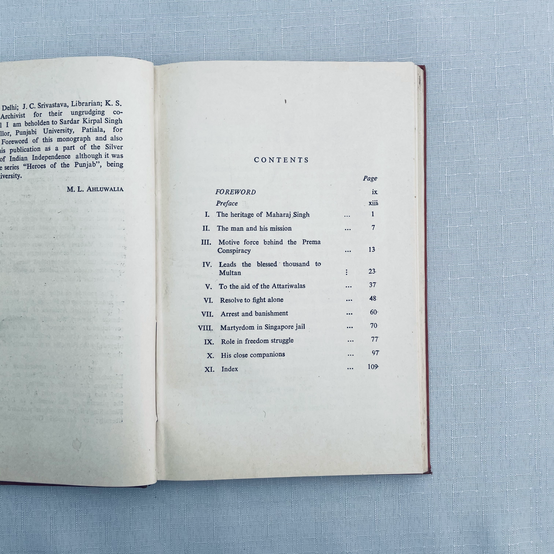Bhai Maharaj Singh by M. L. Ahluwalia
- Admin

- May 10, 2021
- 3 min read
The legacy of Bhai Maharaj Singh is one that shaped the socio-political landscape of the Punjab during its annexation by the British in the mid 1800s. Yet there is little work published to solely reflect his life and character. To that, M. L. Ahluwalia’s work is one that provides great insight and understanding into what Bhai Maharaj Singh represented and the impact he had on the Sikh panth. This particular copy is a first edition, published in 1972 by Punjab University Patiala.
“Sant Nihal Singh, popularly known as Bhai Maharaj Singh, was one of those noble persons who spearheaded the freedom struggle soon after the British has realised their much-cherished aim of flying the Union Jack over the citadel of Lahore in place of the saffron-colour flag of the Sarkar Khalsa ji.” - Preface, M. L. Alhuwalia
Alhuwalia’s work covers the context behind the early life of Bhai Maharaj Singh, his overall mission, historical elements of his role in challenging the British annexation of Punjab and then his eventual arrest and martyrdom in jail in Singapore. Alhuwalia then concludes with a chapter describing Bhai Maharaj Singh’s role in the freedom struggle, highlighting his influence on the surrounding rebellion in Punjab and his connection to revolutionary movements that followed.
“Thus ever since Bhai Maharaj Singh gave a clarion call to the Punjabis to get rid of the foreign rule, the struggle for freedom continued unabated although its methodology had to witness many a change in accordance with the varying circumstances” - Page 96, Chapter IX. Role in Freedom Struggle
Bhai Maharaj Singh’s early life begins with his influence by Bhai Bir Singh, who himself had led an extraordinary life. In approximately 1808, Bhai Bir Singh had initially joined the contingent of Sardar Nihal Singh Attariwala. He would go on to participate in the campaigns of Maharaja Ranjit Singh and eventually the warrior that was Bhai Bir Singh would be replaced by the devotee in him.
It was at Bhai Bir Singh’s derah in Naurangad that Bhai Maharaj Singh began to develop a close relationship with Bhai Bir Singh, having witnessed his mission “bring about the same attitude of purification and selfless service among Sikhs which was their greatest virtue during the times of the ten Gurus.” Unfortunately, the political instability that was consuming Punjab after the demise of Maharaja Ranjit Singh meant that Bhai Bir Singh was caught in the crossfire and his death was caused by a bullet wound. It was at this time when Bhai Maharaj Singh was succeed Bhai Bir Singh’s place. However, following the Anglo-Sikh war in 1845-46, Bhai Maharaj Singh would seek an alternative path with the guidance of this rich spiritual heritage.
The years that follow see Bhai Maharaj Singh take an active role in the movement for freedom in Punjab, through working with Maharani Jind Kaur and fighting against the British alongside the Attariwalas during the second Anglo-Sikh wars. The surrender of Raja Sher Singh Attariwala in March 1849 was a moralistic blow to the rebel soldiers, however Bhai Maharaj Singh would not let this be the end of his mission. At this point, he would continue almost alone. It was then around December 1849 that Bhai Maharaj Singh would be captured by the British, about 14 miles from Jalandhar. Alhuwalias chapter ‘Arrest and Banishment’ complies a range of first hand accounts from British secret consultations, which build a detailed picture of the events that occur shortly after Bhai Maharaj Singh’s capture. It was then in May 1850 that Bhai Maharaj would be deported to Singapore.
“The Saint of Naurangabad thus left the shores of mother India quite unconcerned about his own future but naturally worried about the future of the Punjab who’s freedom he had staked his all” - Page 69, Chapter VII. Arrest and Banishment
Imprisoned in harsh conditions in Singapore, Bhai Maharaj Singh’s health deteriorated to a point where he became completely blind in 1854 and developed tongue cancer in 1856. As with the previous chapter, Alhuwalia draws from a series of secret consultations during that time to build a detailed image of the conditions of Bhai Maharaj Singh and his companion Kharak Singh. Having succumbed to these diseases, Bhai Maharaj Singh left his human body in July 1856.












תגובות